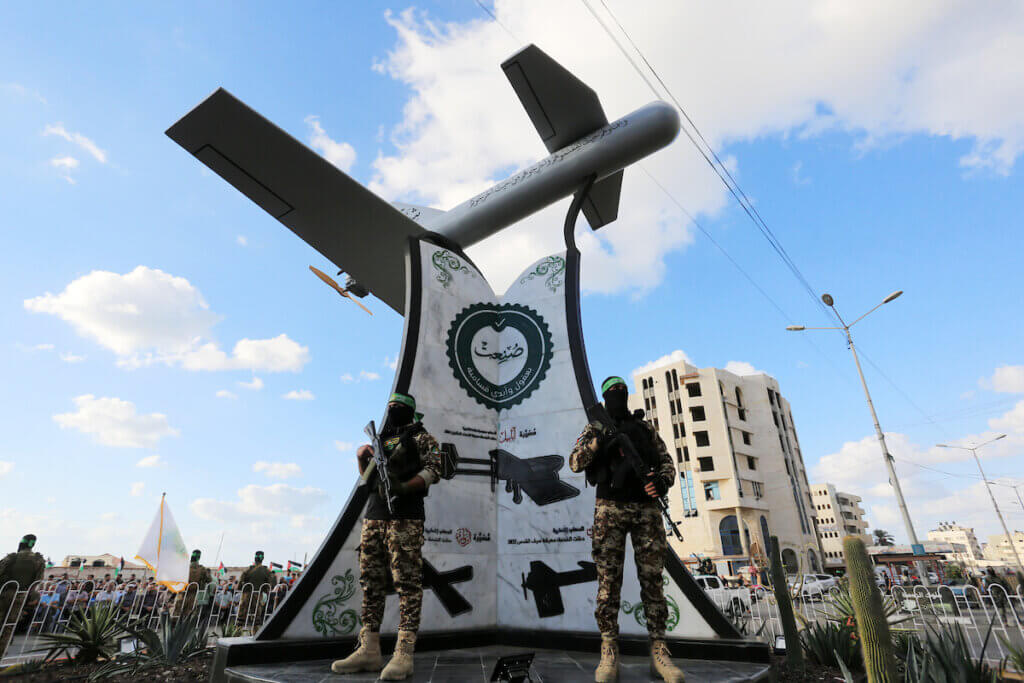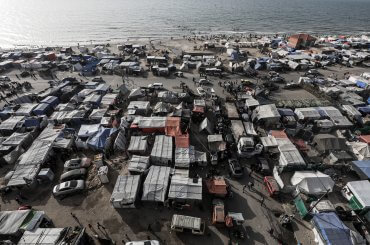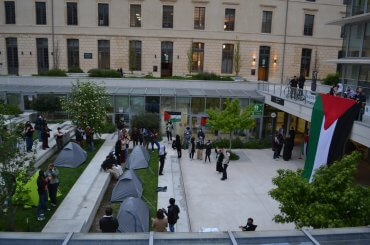During the Israeli invasion of Jenin on July 3 – 4, people in Gaza lived their own fears of being dragged into another Israeli invasion that would leave Gaza devastated. The fear didn’t come out of nowhere. In 2021, Gaza’s response to Israeli attacks at the al-Aqsa Mosque through rocket fire led to another Israeli war on the besieged coastal enclave during what became known as “the Battle of the Sword of Jerusalem.” Since then, Gaza has endured two more onslaughts and is still reeling from the last one in May, when whole families were wiped out.
The Israeli attacks leave devastation in their wake wherever their bombs drop, but their impact on Gaza is all the more deeply felt given the cumulative effect of the 17-year-long blockade. These dire conditions serve to constrain the Palestinian resistance — specifically Hamas as the ruling power in Gaza, whose action or inaction can mean life or death for the people of Gaza.
That’s why all eyes were on the resistance leadership during the latest Israeli invasion of Jenin. By the end of the operation, the resistance had fired some rockets from Gaza, to little effect on the ground, while no other escalation would follow. This attenuated response is due to the fact that Palestinian factions in Gaza have adopted a varied strategy in how to respond to different levels of Israeli aggression, and not all resistance manifests in the form of rocket fire.
One possible reason for this is that Hamas has recently renewed its ambitions of gaining a foothold in the West Bank. An indication of this is that increasingly sophisticated homemade IEDs, and less effective local rockets, are being constructed in Jenin refugee camp. The local Jenin branch of the Qassam Brigades, Hamas’s military wing, touted those rockets in several videos, and while they have so far remained primitive, that’s how makeshift rockets started in Gaza. They now function as a partial deterrent against Israeli aggression.
But the more obvious and immediate reason is the humanitarian and economic situation in the Gaza Strip, Gaza-based analyst Ahmed Fayyad told Mondoweiss. These worsening conditions have raised the price of resistance.
In some ways, the attempts of the resistance factions to foment armed groups in the West Bank can be seen as a response to these conditions; Gaza is now close to reaching its limit in terms of being able to fight Israel alone after successive Israeli wars and an unending siege, and so the developments in the West Bank have afforded a breather of sorts to the resistance. This has dispersed the resistance effort and spread it to areas of Palestine other than the Gaza Strip.
Developing resistance capabilities
Several decades ago, the Fatah movement led the armed struggle against Zionism in exile, and with the signing of the Oslo Accords, the PLO ceased to be a government-in-exile. Fatah was assigned the responsibility of governing the nascent Palestinian Authority, and that was when armed struggle took a backseat to governance, until it faded away entirely.
This scenario has not panned out in the case of Hamas and its governance of Gaza. Ever since it assumed rule, the Hamas government has developed and used rockets during the successive Israeli wars against Gaza. During the first Israeli war in 2008, the other resistance factions in Gaza joined the battle during 21 days of bombardment, during which Hamas fired 1000 rockets and mortar shells. In this attack, 13 Israeli soldiers were killed, and over 47 Israeli machines, including tanks and armed vehicles, were damaged.
Despite the continued economic strangulation, the resistance demonstrated remarkable achievements in its capabilities. It showcased these developments during the next Israeli attack in 2012, when Israel assassinated one of Hamas’s senior leaders, Ahmad al-Jaabari, to which Hamas responded by firing 1456 rockets in 7 days. Among them was a new G-180 rocket model, named after the slain leader and reaching up to 180 km deep into Israel. For the first time, many of these rockets reached Tel Aviv.
Then came the 2014 war, when Hamas fired over 8000 rockets into Israel during 51 days of Israeli bombardment. In this war, the resistance once again demonstrated another qualitative shift, featuring new long-distance rockets and homemade attack drones. Those 51 days also witnessed the famous Nahal Oz operation, when Qassam Brigade resistance fighters went behind enemy lines using cross-border tunnels and attacked an Israeli army outpost in Nahal Oz, killing 10 Israeli soldiers before retreating. The operation was filmed on a Go Pro camera from the point of view of one of the fighters, going viral on social media.
The war showed the capacity of the resistance factions to keep fighting until the last moment — an increase in the capacity to resist.
Seven years later, the resistance in Gaza did something it had never done before — it responded to Israeli aggression not on Gaza, but on al-Aqsa. In May 2021, Israeli forces and settlers raided the al-Aqsa compound several times, arresting and injuring hundreds of worshipers. The general leader of the al-Qassam Brigades released a statement threatening Israel that it had one hour to withdraw from al-Aqsa. It wasn’t an empty threat.
After the hour passed, rockets from Gaza were fired into Israel, and a few hours later, the war broke out, but this time, it was at the initiative of the resistance, which was aspiring to assert its own deterrence against Israeli provocations. The aptly-named “Battle of the Sword of Jerusalem” came in the middle of the Unity Intifada of that same month, which saw the rising up of the Palestinian people across geographic demarcations in Palestine, from the river to the sea. It was also the same month in which the resistance factions in Gaza began propagating the concept of wihdat al-sahat, or “the unity of fields.”
Resistance against the Zionist colonial presence was no longer isolated to the Gaza resistance alone.
The basic logic behind the concept was simple: resistance against the Zionist colonial presence was no longer isolated to the Gaza resistance alone — it would include resistance from every quarter, within Palestine and beyond. As if prophetically, the following year saw the resurgence of armed Palestinian resistance in the West Bank, in part due to funding from resistance factions in Gaza itself.
But this shift from fighting on the Gaza front to expanding the field of battle to the West Bank is also indicative of the government’s desire to lighten the burden of resistance that has been placed on Gaza since 2008.
How Hamas has conducted itself in subsequent Israeli aggressions further demonstrates this. Israel’s “Operation Breaking Dawn” in August 2022 and its attack on Gaza last May were both entirely waged against the Palestinian Islamic Jihad (PIJ). Hamas did not use its full power during these wars.
“Hamas is responsible for the people of Gaza, and it has its own considerations in terms of improving living conditions in the Strip. This may constrain the resistance in Gaza and push the movement to consider the economic situation above the prospect of responding to Israeli aggressions,” Fayyad told Mondoweiss. “But there may be other reasons, like preparing for upcoming attacks in the future,” he added.
This policy of avoiding direct confrontation with the enemy remains fairly recent, and has only arisen since the PIJ has taken on a more active role in fomenting resistance cells in the West Bank. Fayyad thinks that Hamas’s policy is born of the desire to avoid wide-ranging destruction in the strip or of incurring devastating civilian casualties. “Hamas is not like any other faction in Gaza,” he said. “It rules the Gaza Strip, so there must be a balance between its reaction to the Israeli escalation and its administration.”
Yet the ability of the resistance to respond, or indeed the threat of a response, is what has given Hamas its newfound ability to dissuade Israeli actions. “But this exacts a high price for Gaza,” Fayyad told Mondoweiss. “So now the resistance does not react directly to what is happening in the West Bank.”
That much can’t be said of Israel. As armed resistance groups continue to develop their capabilities in the West Bank, Gaza has more than once been pulled into the fray by the enemy, as Israel has launched several “preemptive strikes” against the PIJ leadership in an effort to strike the West Bank resistance at its perceived source. The wars in 2022 and 2023 were just that, and the reason is that Hamas has allowed armed groups like the PIJ to operate freely in Gaza.
Resistance, brought to you by the government
Even though Hamas’s armed resistance is constrained by its responsibilities as a ruling government in Gaza, it has not stood in the way of the activities of the other resistance factions. In stark contrast to the PA — which openly arrests and suppresses armed Palestinian groups — Hamas as an organization supports and endorses armed resistance. The result is that, while Hamas has reduced its response to attacks that do not directly target it as an organization, it also gives other factions a greater freedom in arming themselves without being targeted from the inside.
“What makes Gaza different is that it is under Hamas rule, and Hamas is a movement that adopts resistance and supports it,” a military spokesperson of the Popular Front for the Liberation of Palestine in Gaza, Abu Jamal, told Mondoweiss. “So resistance in Gaza gets government support. Fighters move freely and store equipment. They establish facilities, open up centers, and set up military sites.”
For the first time in decades, Palestinian action has entered the deterrence equation.
“Every battle in Gaza develops the resistance’s capabilities even further,” Abu Jamal continued. “Years ago, we could only target the occupied towns [near Gaza], and after that, we started targeting major centers of the Occupation. Our targets will only expand further in the future.”
For a time, Israel has reveled in its success at dividing Palestinians and relegating armed resistance to a single geographic space. But Palestinian resistance is less atomized today than it was in 2008, and it is in no small part due to the same strategic orientation that gave birth to “the unity of fields.”
What this means is that for the first time in decades, Palestinian action has entered the deterrence equation.



Gazans must be angling for two states, not one.
What is the record of Hamas in government so far? I can find little online that gives much recent analysis regarding aspects such as women’s rights, protections for Palestinians in the workplace and such – the things that ordinary Palestinian people no doubt experience daily and find important. Perhaps someone can point me to a source.
Interestingly, the deterrence Israel likely feels is Western public opinion judging it over reacting. Thus a particularly successful resistance operation, say one that kills 14 soldiers would provide justification for very significant action. No questions asked and no winners.
Terminology like government, state, and war belong to Zionist propaganda if they are applied anywhere in Palestinian Occupied Territory. Use of this terminology is characteristic of Zionist mental colonization or of a Zionist propagandist.
Hamas is a native resistance movement in occupied Palestine and tries to take care of civilians in areas over which Hamas has some control.
When brent or Rebecca Turner use terms like government, state, or war, they are repeating Zionist propaganda.